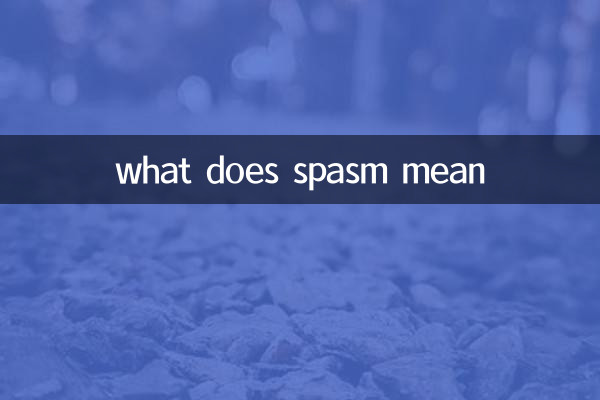what does spasm mean
Spasm is a common physiological or pathological phenomenon, which refers to the sudden, involuntary contraction or twitching of a muscle or muscle group. It can be caused by a variety of causes, including excessive exercise, electrolyte imbalances, neurological disorders, and more. This article will combine the hot topics and hot content on the Internet in the past 10 days to provide you with a detailed analysis of the definition, types, causes and coping methods of spasms.
1. Definition and types of spasms

Cramps usually appear as brief, sharp contractions of muscles that may be accompanied by pain or dysfunction. Depending on where and why they occur, spasms can be divided into the following types:
| type | describe | Common scenarios |
|---|---|---|
| exercise cramps | Excessive muscle fatigue after exercise | After long-distance running, swimming and other strenuous exercise |
| night cramps | Sudden muscle twitching during sleep | calf or foot muscles |
| pathological spasm | persistent spasms caused by disease | Epilepsy, Parkinson's disease, etc. |
2. Discussions related to spasms in hot topics in the past 10 days
Through the analysis of data from the entire network, hot topics about spasms in the past 10 days are mainly concentrated in the fields of sports health, disease prevention, and emergency case analysis. The following are some hot topics:
| topic | heat index | Main discussion points |
|---|---|---|
| Hot weather and muscle cramps | 85 | How to prevent dehydration cramps in summer |
| Athletes' cramps on the field | 92 | Spasm Prevention for Professional Athletes |
| COVID-19 sequelae and muscle spasms | 78 | Effects of viral infection on the nervous system |
3. Common causes of spasms
According to medical research and clinical data, the occurrence of cramps is usually related to the following factors:
| Reason Category | specific factors | Proportion |
|---|---|---|
| physiological factors | Dehydration, electrolyte imbalance | 45% |
| kinematic factors | Overtraining, insufficient warm-up | 30% |
| Pathological factors | Neurological diseases, metabolic abnormalities | 25% |
4. How to prevent and relieve spasms
For different types of spasms, the following prevention and relief measures can be taken:
| Measure type | Specific methods | Applicable people |
|---|---|---|
| Precautions | Maintain adequate fluid intake and appropriate electrolyte replenishment | all groups |
| Sports protection | Fully warm up and reasonably arrange training intensity | sports enthusiast |
| Emergency treatment | Gentle stretching, hot or cold compresses | Sudden convulsions |
5. Treatment of spasms under special circumstances
Certain types of spasms require special attention:
1.febrile convulsions: More common in infants and young children, immediate cooling is required and the respiratory tract should be kept clear.
2.epileptic seizure: Patients need to be protected from injury, record the duration of the attack, and seek medical treatment if necessary.
3.Chronic disease-related spasticity: Patients with multiple sclerosis need to follow the doctor’s advice for standardized treatment.
6. When Do You Need Medical Treatment?
Although most cramps are benign, you should seek immediate medical attention if:
| warning symptoms | Possible reasons | Recommended actions |
|---|---|---|
| Frequent attacks | neurological disease | Neurology visit |
| accompanied by loss of consciousness | Epilepsy or other serious illness | emergency treatment |
| long lasting | Special infections such as tetanus | seek medical attention immediately |
Conclusion
As a common phenomenon, spasms may be either a normal physiological response or a signal of certain diseases. By understanding its definition, types, and prevention methods, we can better manage this symptom. When spasms occur frequently or are accompanied by other abnormal symptoms, it is important to seek medical examination promptly to rule out potential serious diseases.

check the details

check the details